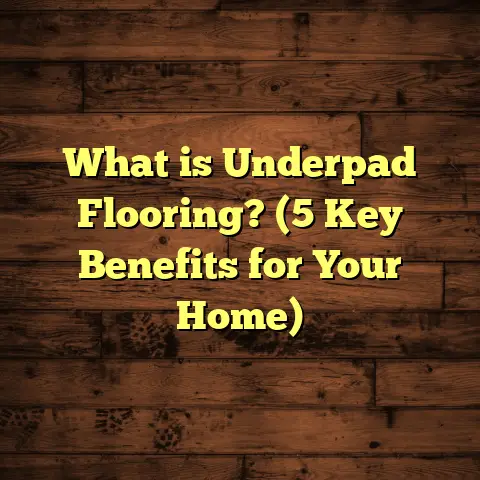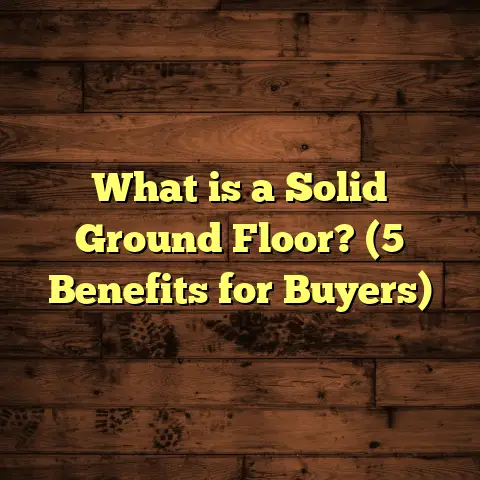What is a Wooden Floor? (5 Benefits You Didn’t Know About!)
I once had a homeowner ask me a simple question that made me realize many people don’t truly grasp what wooden floors are all about: “Isn’t wood just wood? What makes a wooden floor special?” I could tell they were overwhelmed by all the flooring options available and skeptical if wood was worth the investment or the effort. This kind of confusion is common. Many folks like you may have heard about wooden floors but might not know why they’ve remained popular for centuries or what unique benefits they bring beyond just good looks. So, I’m going to break it down for you—and share some benefits you probably haven’t heard before.
What is a Wooden Floor?
When someone says “wooden floor,” they’re generally referring to a floor surface made from wood. But there’s a lot more beneath the surface of that simple phrase. Wood flooring comes primarily in two forms: solid hardwood and engineered hardwood. Each has its own characteristics, installation methods, and benefits.
Solid Hardwood Floors
Solid hardwood floors are made from a single piece of timber cut from trees like oak, hickory, maple, cherry, or walnut. The thickness usually ranges from 3/4 inch to 5/16 inch in thinner planks. Because it’s solid wood all the way through, it can be sanded and refinished multiple times over its lifetime. This type of flooring is what you often see in historic homes or high-end renovations.
Engineered Hardwood Floors
Engineered hardwood has a thin layer of real wood on top—called the veneer—bonded over several layers of plywood or high-density fiberboard. These layers are arranged in a cross-grain pattern to enhance stability and prevent expansion or contraction due to moisture changes. Engineered wood can be installed in places where solid wood might struggle, like basements or over concrete slabs.
Why Wood?
Wood is a natural material with unique grain patterns and colors that give every plank its own personality. Unlike synthetic flooring materials that try to replicate wood’s appearance (like laminate or vinyl), nothing quite matches the authentic look and feel of real wood underfoot.
Wood also ages beautifully. Over time, it develops a patina—a soft glow from years of sunlight, foot traffic, and polishing—that adds character rather than detracts from it.
1. Longevity That Pays Off
I’ve installed hundreds of wooden floors over the years, and one thing I always tell my clients is this: wooden floors are an investment that pays off over decades. When properly maintained, hardwood floors can last 50 years or more—and sometimes well over 100 years.
Why Do Wooden Floors Last So Long?
The secret lies in the durability of hardwood species and their ability to be restored. Unlike carpet or vinyl—which wear out and need replacing—wood floors can be sanded down to remove scratches, dents, or stains, then refinished with new coats of protective finish. This process can be repeated multiple times throughout the floor’s life.
For instance, oak floors can typically be sanded and refinished 6-8 times before the wood layer is too thin. This means even after decades of use, you can restore your floor to look nearly brand new.
Case Study: My Client’s Century-Old Oak Floor
A few years ago, I worked on a renovation project for a Victorian home built in 1905. The original oak flooring was still intact but badly scratched and worn from over 100 years of family life. After careful sanding and refinishing, the floor looked stunning—just like it did when first installed. The homeowners were thrilled because they had saved the original character of their home without replacing the expensive flooring.
Data on Longevity
- According to the National Wood Flooring Association (NWFA), hardwood floors can last anywhere from 30 to 100 years depending on species and maintenance.
- A 2018 survey found that 85% of homeowners who installed hardwood floors were still satisfied with their floors after more than 20 years.
Sounds like a smart investment, right? You won’t find many flooring materials that offer this kind of long-term value.
2. Natural Air Quality Booster
Here’s something many people don’t realize: your floor choice affects indoor air quality more than you might think.
Carpets Trap Allergens
Carpet fibers trap dust mites, pet dander, pollen, and other allergens. Even with regular vacuuming, these particles accumulate deep inside carpet padding where they can cause allergic reactions or worsen asthma symptoms.
Wood Floors Keep Air Cleaner
Unlike carpet, hardwood floors don’t harbor these irritants because they have a smooth surface that’s easy to clean thoroughly. Dusting and sweeping regularly are enough to keep allergens at bay.
Research Backing This Up
A study published by Allergy Standards Limited tested homes with different floor types and found that houses with hardwood floors showed significantly lower levels of indoor allergens compared to carpeted homes. Another research paper in the Journal of Allergy and Clinical Immunology supports this by linking hard surface flooring with reduced asthma symptoms in children.
Personal Experience
I once helped a family whose son had severe allergies switch from wall-to-wall carpet to hardwood floors throughout their home. After just a few months, they noticed fewer sneezing episodes and better sleep quality for their child. It was a small change with a big health impact.
3. Energy Efficiency and Comfort
Have you ever stepped barefoot on tile during winter and felt like your feet instantly froze? Wooden floors offer different thermal properties that affect how your home feels.
Why Is Wood Warmer Underfoot?
Wood is a natural insulator thanks to its cellular structure filled with air pockets. These pockets slow down heat transfer between your feet and the cold subfloor below.
This means wooden floors retain warmth better than tile or stone surfaces, making your living space feel cozier without needing to blast the heater.
Real-World Example from My Installations
I once installed oak flooring in a drafty old farmhouse where previous owners complained about cold floors in winter. After installation, the family reported feeling warmer even before turning on the heating system because the wooden floor held onto room temperature better.
Energy Savings Data
The U.S. Department of Energy notes that better insulation reduces heating costs by around 10-20%. While wood flooring alone won’t solve all heating issues, it contributes by minimizing heat loss through floors.
Some studies suggest homes with hardwood floors use less energy for heating compared to homes with tile or concrete flooring exposed to colder temperatures.
4. Timeless Style That Adds Value
When you choose wooden floors, you’re not just picking a surface; you’re adding character and style to your home that never goes out of fashion.
Why Does Wood Look So Good?
Wood has natural color variations—ranging from pale blond maple to rich reddish cherry—that create visual interest without overwhelming the space. Its grain patterns add texture that changes subtly depending on light angle and viewing distance.
Versatility Across Design Styles
Whether your taste leans toward rustic farmhouse charm or sleek modern minimalism, wooden floors adapt well because they’re neutral but full of personality.
I’ve seen clients pair dark walnut flooring with white walls for a striking contrast or use light oak planks in Scandinavian-inspired rooms for an airy feel.
Impact on Home Resale Value
From conversations with real estate agents and analysis by the National Association of Realtors (NAR), homes with hardwood floors tend to sell faster and for higher prices than those without.
- NAR data shows homes with hardwood flooring sell for an average of 2-5% more.
- Buyers often rate wooden floors as one of their top features when shopping for homes.
- Homes with hardwood floors spend an average of 10 days less on the market compared to similar homes without them.
When I helped renovate my own house years ago by installing wide-plank oak flooring, I noticed immediate interest from buyers during open houses—they appreciated how warm and inviting the space felt thanks partly to the wood floor.
5. Environmentally Friendly Choice
With so much attention on sustainability today, choosing materials that respect the environment has become more important than ever.
Wood Is Renewable
Unlike products derived from fossil fuels like vinyl or synthetic carpet fibers, wood comes from trees—renewable resources that absorb carbon dioxide as they grow.
If forests are managed sustainably (through replanting and responsible logging), harvesting wood for flooring can be part of a healthy ecosystem cycle rather than destructive practice.
Certification Matters
When selecting wood flooring, look for certifications like FSC (Forest Stewardship Council) or PEFC (Programme for the Endorsement of Forest Certification). These labels ensure timber comes from responsibly managed forests that preserve biodiversity and protect workers’ rights.
Using Reclaimed Wood
Reclaimed wood flooring uses salvaged timber from old buildings or barns. This reduces demand for new lumber and adds unique character due to its aged look and history embedded in each plank.
I once installed reclaimed chestnut flooring in a customer’s living room—it gave the space warmth while cutting down environmental impact compared to new flooring options.
Life Cycle Assessment Data
Government reports confirm that over an entire lifecycle (extraction, manufacturing, installation, use, disposal), hardwood flooring typically has a lower carbon footprint compared to vinyl, laminate, or carpet alternatives—especially if sourced locally.
According to a study by Environmental Building News:
- Hardwood flooring produces about half the greenhouse gas emissions per square foot compared to vinyl.
- Its biodegradability ensures less landfill waste at end-of-life.
- Durability means fewer replacements over decades—further reducing environmental impact over time.
More Benefits You Might Not Expect
Beyond these five big advantages, wooden floors offer other subtle but meaningful perks I want to share:
Acoustic Comfort
Wood absorbs sound better than tile or concrete but doesn’t deaden noise like carpet does. This balance creates pleasant acoustics in your home where voices don’t echo harshly but sounds aren’t completely muffled either—a comfortable middle ground for everyday living.
In my experience installing floors in apartments and condos, tenants appreciate how wooden floors reduce noise transmission between units compared to bare concrete slabs but still provide lively ambiance.
Easy Maintenance
With just regular sweeping or vacuuming plus occasional damp mopping using specially formulated wood cleaners, wooden floors stay looking great without intensive upkeep routines required by some other materials like carpet shampooing or grout cleaning for tiles.
I often hear clients say they prefer wood because spills are easy to clean up quickly without staining—something carpet owners envy!
Compatibility With Radiant Heating
Engineered wooden floors work well over radiant heating systems because they resist warping better than solid wood under fluctuating temperatures. If you’re planning radiant heat under your floor (a popular choice in colder climates), engineered wood might be your best bet without losing that essential warmth wood brings.
How To Choose The Right Wooden Floor For You
Choosing wooden flooring isn’t one-size-fits-all—it depends on your lifestyle, budget, and aesthetic preferences. Here’s what I usually recommend considering:
Species & Hardness
Some woods are harder and more resistant to dents or scratches—like hickory or maple—while others like pine are softer but have more rustic charm.
The Janka hardness scale rates woods for their resistance:
- Hickory: ~1,820 lbf (very hard)
- Oak: ~1,290 lbf (hard)
- Maple: ~1,450 lbf
- Pine: ~420 lbf (soft)
If you have kids or pets that tend to scratch floors easily, harder woods are more practical.
Finish Types
Wood floors come sealed with finishes like polyurethane (oil-based or water-based) which protect from moisture and wear:
- Oil-based finishes add amber warmth but take longer to dry.
- Water-based finishes dry quickly and keep color lighter but may need more frequent recoating.
Natural finishes like wax or oil penetrate wood differently but require more maintenance.
Plank Width & Color
Wide planks create a spacious feel but can show gaps as wood expands/contracts seasonally.
Narrow planks offer classic looks but may appear busier visually.
Lighter colors brighten rooms; darker hues add drama but show dust more easily.
My Flooring Installation Process: What You Can Expect
When I install wooden floors for clients, here’s how I usually approach it:
- Assessment & Measurement: I measure precisely and check subfloor conditions.
- Material Selection: We discuss species, finish options based on client needs.
- Preparation: Subfloor is cleaned and leveled if needed.
- Installation: Boards are laid using nails/staples/glue depending on type.
- Sanding & Finishing: For unfinished wood floors; prefinished ones arrive ready.
- Curing Time: Floors left undisturbed for days so finishes harden fully.
- Final Inspection: Walkthrough with client ensuring satisfaction.
This detailed process ensures durability and beauty last for decades—not just months.
Common Questions About Wooden Floors
Q: Are wooden floors good for kitchens?
A: Yes! Especially engineered wood which handles moisture better than solid hardwood if sealed properly—but spills should still be cleaned quickly.
Q: Can wooden floors go in bathrooms?
A: Generally not recommended due to high moisture levels causing warping unless you choose specialized waterproof engineered options designed for wet areas.
Q: How do wooden floors handle pets?
A: Scratch-resistant finishes help protect surfaces; harder woods fare better against claws.
Q: What about underfloor heating?
A: Engineered wood works well; solid hardwood needs extra care due to expansion risks.
Wrapping It Up (Without Saying ‘In Conclusion’)
Wooden floors are so much more than just beautiful surfaces underfoot—they offer practical benefits that touch your health, comfort, wallet, style sense, and environmental values all at once. From lasting decades through wear-and-tear to improving air quality naturally; from creating energy-efficient cozy spaces to boosting home value; plus being kind on the planet when chosen responsibly—wooden flooring really stands out as one of the smartest home improvement investments you can make.
Are you thinking about upgrading your floors? What questions or concerns do you have? I’d love to share more insights from my years installing wooden floors and help you make choices that fit your home perfectly.





